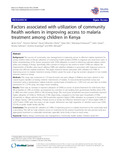Factors associated with utilization of community health workers in improving access to malaria treatment among children in Kenya

View/
Date
2012-07-30Author
Kisia, James
Nelima, Florence
Otieno, David O
Kiilu, Kioko
Emmanuel, Wamalwa
Sohani, Salim
Siekmans, Kendra
Nyandigisi, Andrew
Akhwale, Willis
Type
Journal ArticleMetadata
Show full item recordAbstract
Abstract
Background
The success of community case management in improving access to effective malaria treatment for young children relies on broad utilization of community health workers (CHWs) to diagnose and treat fever cases. A better understanding of the factors associated with CHW utilization is crucial in informing national malaria control policy and strategy in Kenya. Specifically, little is known in Kenya on the extent to which CHWs are utilized, the characteristics of families who report utilizing CHWs and whether utilization is associated with improved access to prompt and effective malaria treatment. This paper examines factors associated with utilization of CHWs in improving access to malaria treatment among children under five years of age by women caregivers in two malaria endemic districts in Kenya.
Methods
This study was conducted in 113 hard-to-reach and poor villages in Malindi and Lamu districts in the coastal region classified as having endemic transmission of malaria. A cross-sectional household survey was conducted using a standardized malaria indicator questionnaire at baseline (n = 1,187) and one year later at endline assessment (n = 1,374) using two-stage cluster sampling.
Results
There was an increase in reported utilization of CHWs as source of advice/treatment for child fevers from 2% at baseline to 35% at endline, accompanied by a decline in care-seeking from government facilities (from 67% to 48%) and other sources (26% to 2%) including shops. The most poor households and poor households reported higher utilization of CHWs at 39.4% and 37.9% respectively, compared to the least poor households (17.0%). Households in villages with less than 200 households reported higher CHWs utilization as compared to households in villages having >200 households. Prompt access to timely and effective treatment was 5.7 times higher (95% CI 3.4-9.7) when CHWs were the source of care sought. Adherence was high regardless of whether source was CHWs (73.1%) or public health facility (66.7%).
Conclusions
The potential for utilization of CHWs in improving access to malaria treatment at the community level is promising. This will not only enhance access to treatment by the poorest households but also provide early and appropriate treatment to vulnerable individuals, especially those living in hard to reach areas.
URI
http://dx.doi.org/10.1186/1475-2875-11-248http://erepository.uonbi.ac.ke:8080/xmlui/handle/123456789/14683
